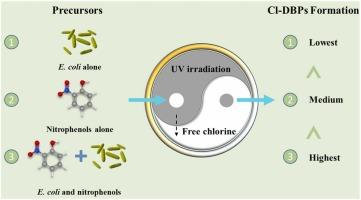Formation of halonitromethanes, dichloroacetonitrile, and trichloromethane in the presence of E. coli and nitrophenols during UV/post-chlorination
IF 12.2
1区 环境科学与生态学
Q1 ENGINEERING, ENVIRONMENTAL
引用次数: 0
Abstract
Nitrophenols and E. coli widely coexist in surface water and can form chlorinated disinfection byproducts (Cl-DBPs) in chlorine-based disinfection processes. However, the coexistence of nitrophenols and E. coli affecting Cl-DBPs formation has not been reported. Herein, the formation of chlorinated halonitromethanes (Cl-HNMs), dichloroacetonitrile (DCAN), and trichloromethane (TCM) in the simultaneous presence of nitrophenols and E. coli was investigated in the UV/post-chlorination process. Results indicated the coexistence of nitrophenols and E. coli ((1-2) × 105 CFU mL-1) enhanced Cl-DBPs formation, but excessive E. coli ((1-2) × 107 CFU mL-1) dramatically inhibited that. Moreover, appropriate UV fluences promoted Cl-DBPs formation, and increasing chlorine dose and nitrophenol concentration enhanced that. Besides, alkaline pH decreased Cl-HNMs and DCAN formation but facilitated TCM formation. Subsequently, the Cl-DBPs formation mechanisms and pathways were explored in the simultaneous presence of E. coli and nitrophenols. When nitrophenols and E. coli were present in real waters, more complicated formation phenomena of Cl-DBPs were observed compared to those in simulated waters (SWs). Finally, Cl-DBPs generated in real waters exhibited lower toxicities than those generated in SWs. This study provides new insights into Cl-DBPs formation in the presence of organic substances and bacteria, simultaneously contributing to a better UV/post-chlorination process application.

求助全文
约1分钟内获得全文
求助全文
来源期刊

Journal of Hazardous Materials
工程技术-工程:环境
CiteScore
25.40
自引率
5.90%
发文量
3059
审稿时长
58 days
期刊介绍:
The Journal of Hazardous Materials serves as a global platform for promoting cutting-edge research in the field of Environmental Science and Engineering. Our publication features a wide range of articles, including full-length research papers, review articles, and perspectives, with the aim of enhancing our understanding of the dangers and risks associated with various materials concerning public health and the environment. It is important to note that the term "environmental contaminants" refers specifically to substances that pose hazardous effects through contamination, while excluding those that do not have such impacts on the environment or human health. Moreover, we emphasize the distinction between wastes and hazardous materials in order to provide further clarity on the scope of the journal. We have a keen interest in exploring specific compounds and microbial agents that have adverse effects on the environment.
 求助内容:
求助内容: 应助结果提醒方式:
应助结果提醒方式:


